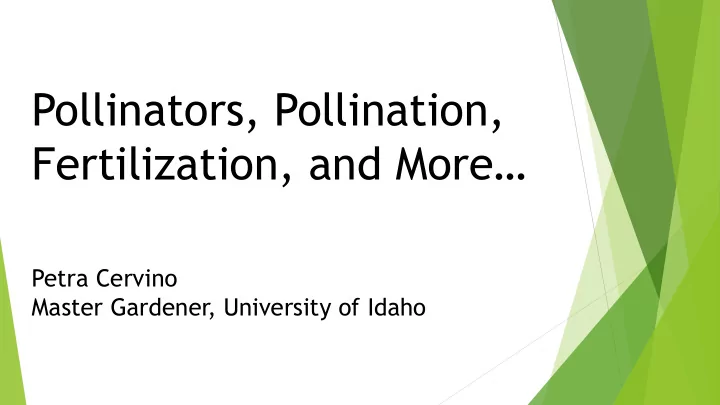

Pollinators, Pollination, Fertilization, and More… Petra Cervino Master Gardener, University of Idaho
Example Have a question or comment? Click to mute and unmute Have a question or comment? Click on the chat icon to pop up the window (on your right) to Click to Exit Click to be part Meeting type your question(s)/ of the face time comments(s). video
Pollinators, Pollination, Fertilization…. University of Idaho Master Gardener Program • Who are they? • Pollination 101 • What is pollination? • What is fertilization? • Attracting pollinators in the garden •
University of Idaho Master Gardener Program 5880 N. Glenwood St., Boise, ID • 208-287-5900 • https://www.uidaho.edu/extension/master-gardener •
Pollinators • Who are they?
Pollination and Fertilization 101
What is Pollination? The transfer of pollen from a male part of • a plant to a female part of a plant Later enabling fertilization and the • production of seeds. This usually happens by an animal, insect • or wind.
What is Fertilization? • Merging of the male and female genes to create seeds, fruit etc.
Petal Stigma Sepal Pistil Style (Female) Ovary/Ovules Anther Anther Stigma Stamen (Male) Filament
Not all plants produce flowers with both the male and female parts. Those are noted as imperfect. Plants that produce separate male and female flowers on the same plant are called monoecious (men-ee-cious) (Latin meaning “one house”). Examples of this type of arrangement are cucumbers., pumpkins, corn, and European white birch. Other species may have separate male and female plants with flower of only one sex on any plant. This is called dioecious (die-ee- cious ) (again, Latin meaning “two houses). One example of this is holly. Only the female plant will produce berries and a male plant is close by to supply the pollen. Other examples of this type of arrangement is asparagus, spinach, and Japanese yew.
Attracting Pollinators in the Garden
As a general rule…. • Plants that require pollinators usually have large and/or bright/showy petals and flowers • Wind-pollinated plants tend to have inconspicuous flowers
Bee Culture (The Magazine of American Beekeeping) May 20, 2016
Tips for creating a pollinator habitat • Plant your garden so something is always flowering from early spring into late fall. • Crocuses, tulips, etc. can start their food supply in the spring
Tips for creating a pollinator habitat • Also, some of our native bee pollinators need a place to call home. • In the fall, limit fall cleanup to establish a habit where they can overwinter by leaving some leaves on the ground and not cutting your herbaceous perennials back. • Leave a small bare area; they can nest in the ground.
Suggestions
Questions & Answers?
Thank you!
Recommend
More recommend